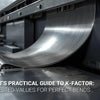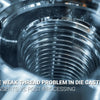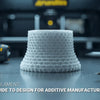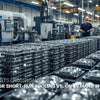How Can You Master CNC Machining Design for Optimal Manufacturing Results?

How Can You Master CNC Machining Design for Optimal Manufacturing Results?

Are you looking to optimize your product design for CNC machining? Whether you're an engineer, designer, or manufacturer, understanding the fundamentals of CNC machining design can significantly impact your product's quality, cost, and production efficiency.
In this comprehensive guide, we'll walk you through everything you need to know about designing for CNC machining, from basic principles to advanced optimization techniques.
The world of CNC machining is constantly evolving, with precision tolerances reaching new heights and manufacturing capabilities expanding. By mastering these design principles, you can ensure your parts are not just manufacturable, but also cost-effective and high-performing.
Let's dive into the essential elements that will help you create better designs for CNC machining.
Table of Contents
- Essential Elements of CNC Machining Design
- Different CNC Machining Processes and Design Impact
- Design Principles for Successful CNC Machined Parts
- Material Selection Criteria
- Tolerances and Surface Finishes
- Cost Optimization Strategies
What Are the Essential Elements of CNC Machining Design?
Understanding the fundamental elements of CNC machining design is crucial for successful manufacturing outcomes. These elements form the foundation of every well-designed CNC machined part.
When approaching CNC machining services, designers must consider various factors such as material properties, tool accessibility, and manufacturing constraints. These considerations directly impact the final product's quality and cost-effectiveness.
A well-designed CNC part incorporates:
- Appropriate wall thicknesses
- Suitable corner radii
- Proper draft angles
- Strategic feature placement
How Do Different CNC Machining Processes Impact Your Design Choices?
Different CNC processes require distinct design approaches. Understanding these variations is crucial for optimizing your design for the specific manufacturing method.
CNC turning and CNC milling each have unique capabilities and limitations that significantly influence design decisions.
CNC Turning Considerations
- Symmetrical features are optimal
- Maximum length-to-diameter ratio should not exceed 4:1 for standard operations
- Minimum groove width of 2mm for external features
- Internal features require consideration of boring bar limitations
- Thread designs should follow standard specifications
CNC Milling Specifications
- Tool access angles typically range from 0° to 90°
- Minimum internal corner radius should match tool diameter
- Deep pockets should not exceed 4x tool diameter in depth
- Consider step-over requirements for surface finish
- Account for fixturing requirements in the design
Process-specific design requirements include:
- Tool reach and accessibility limitations
- Feature orientation relative to machine axes
- Multiple setup considerations
- Material removal patterns and cutting forces
- Chip evacuation requirements
Which Design Principles Ensure Successful CNC Machined Parts?
Successful CNC machined parts require careful attention to fundamental design principles that balance manufacturability with functionality.
Critical Design Guidelines
- Wall Thickness Requirements
- Minimum thickness: 0.8mm for metals
- Recommended thickness: >1.5mm for structural integrity
- Variable thickness transitions should be gradual
- Corner and Edge Features
- Internal corners: Minimum radius of 1/3 tool diameter
- External corners: Can be sharp but benefit from small radii
- Edge breaks: 0.2-0.5mm chamfer recommended
- Hole Features
- Minimum diameter: 1.5mm for metals
- Maximum depth: 4x diameter for blind holes
- Standard drill sizes preferred
- Countersinks: 90° or 120° standard angles
- Feature Accessibility
- Design for standard tool lengths
- Consider approach angles
- Allow clearance for tool holders
- Plan for workholding requirements

What Are the Critical Material Selection Criteria for CNC Machining?
Material selection involves balancing multiple factors that affect both manufacturing and end-use performance.
Material Categories and Properties
- Aluminum Alloys
- 6061-T6: Excellent general-purpose use
- 7075-T6: Higher strength applications
- 5052: Good corrosion resistance Machinability: Excellent Cost: Moderate Applications: Aerospace, automotive, prototypes
- Steels
- 1018: General purpose
- 4140: Heat-treatable
- 316 Stainless: Corrosion resistant Machinability: Good to moderate Cost: Moderate to high Applications: Industrial equipment, tooling
- Engineering Plastics
- Delrin/POM: Excellent dimensional stability
- PEEK: High-performance requirements
- UHMW: Low friction applications Machinability: Very good Cost: Varies significantly Applications: Medical, food processing
Selection Factors Matrix
- Mechanical Properties Required
- Tensile strength
- Hardness
- Impact resistance
- Fatigue resistance
- Environmental Considerations
- Temperature range
- Chemical exposure
- UV resistance
- Moisture exposure
Why Do Tolerances and Surface Finishes Matter in CNC Design?
Surface finish and tolerances directly impact part functionality, assembly fit, and manufacturing costs.
Tolerance Classifications
- Standard Tolerances
- ±0.127mm (±0.005"): General machining
- ±0.076mm (±0.003"): Precision features
- ±0.025mm (±0.001"): High precision
- Surface Finish Specifications
- Ra 3.2 (125 μin): Standard finish
- Ra 1.6 (63 μin): Good finish
- Ra 0.8 (32 μin): Fine finish
- Ra 0.4 (16 μin): Mirror finish
Critical Considerations
- Feature relationships
- Geometric dimensioning
- Stack-up tolerances
- Measurement methods
- Cost implications
How Can You Optimize Your Design to Control CNC Machining Costs?
Cost optimization requires strategic design decisions that balance quality requirements with manufacturing efficiency.
Cost Reduction Strategies
- Design Optimization
- Minimize setups required
- Use standard tool sizes
- Avoid unnecessary tight tolerances
- Design for standard material sizes
- Material Considerations
- Optimize raw material usage
- Consider material cost vs. machinability
- Account for material availability
- Plan for efficient nesting
- Manufacturing Efficiency
- Standardize features where possible
- Group similar operations
- Design for maximum tool life
- Consider automation possibilities
- Quality vs. Cost Balance
- Specify critical tolerances only where needed
- Select appropriate surface finishes
- Use functional GD&T
- Consider inspection requirements
Cost Impact Factors
- Setup time required
- Number of tool changes
- Machine runtime
- Material costs
- Secondary operations
- Inspection requirements
Conclusion
Mastering CNC machining design requires understanding multiple interconnected factors:
- Process selection
- Material properties
- Design principles
- Cost considerations
By following these guidelines and principles, you can create designs that are both manufacturable and cost-effective.
External Resources
-
Posted in
CNC machining, CNC Machining Design Guide





